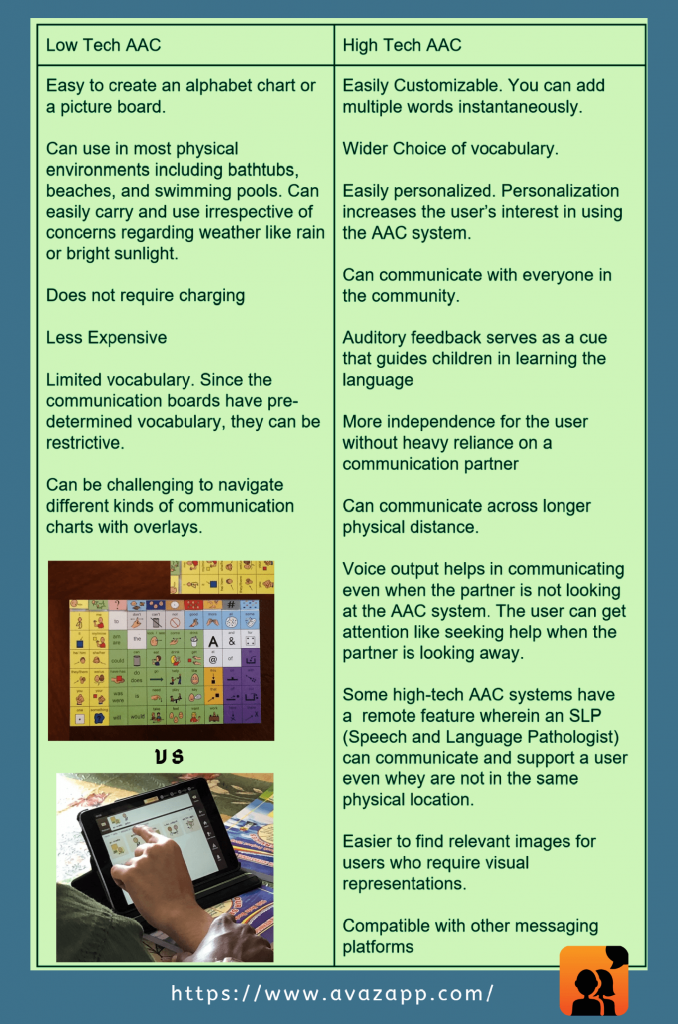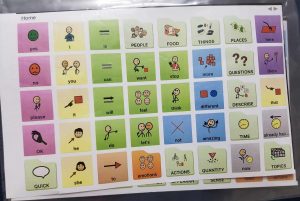High Tech and Low Tech AAC: How to Effectively use both
With high tech AAC devices, the possibilities are truly endless when it comes to providing a voice to those with communication deficits. From remote therapy (teletherapy) to literacy supports, high tech AAC seems to have it all. It makes you wonder if low tech AAC devices are still relevant and useful for children with communication challenges.
AAC (Augmentative and Alternative Communication) helps people with speech and language difficulties communicate with others. Phenomenal technological developments in recent years have broken several barriers and revolutionized the way high-tech AAC is being used. Low-Tech AAC might not be as flamboyant as its high tech counterparts. But it can still serve as a beneficial tool that aids your child’s communication. And the interesting fact is that you can use a combination of high tech and low-tech AAC to enhance your child’s communication skills. Read on to find out how.
Get free communication boards for food, emotions, and shared reading here
Get free Language Builder Resources here
What is Low Tech AAC?
Low-Tech AAC comprises of tools and strategies that do not involve electronics and do not require batteries. Examples of Low-tech AAC are PECS (Picture Exchange Communication System), symbol charts, communication boards, communication books, etc.
The user selects letters, words, or phrases from the communication charts to convey their message. Users can use a body part such as their finger or toe, a head pointer, eye gaze, mouth stick, light pointer or a hand-held pointer for the selection.
People with severe motor and communication impairments may require assistance for using the picture boards or alphabet charts. Partner-assisted scanning is a method where a communication partner scans or presents the messages, letters, or pictures sequentially and the user makes their choice by answering Yes/No questions or with facial expressions.
Low-Tech Vs High-Tech AAC
High-tech AAC comprises of tools and strategies that use electricity, electronics, and batteries. High-tech systems might have a clear edge over low-tech AAC when it comes to the extent of communicative functions they are capable of providing. But low-tech AAC can come in handy in certain physical environments and situations.
High Tech AAC Pros:
- Easier to customize and personalize according to preferences. You can change voices, symbols, and vocabulary level according to the user’s requirements.
- Ability to add vocabulary as per the user’s progress
- Auditory feedback serves as cue for the user to learn language
- Facilitates communication autonomy by giving the user a wide choice of vocabulary
- Ability to instantaneously download pictures from the web for symbol-based communication
- Compatibility of high tech AAC devices with social media and messaging platforms
- More independence for the user with less reliance of the communication partner
Low Tech AAC Pros:
- Less expensive than high tech AAC options
- Easier to create alphabet charts or low tech boards
- Can be used in most physical environments including swimming pools, beaches, bath tubs etc. Laminated communication charts can be used under all weather conditions.
- Does not require charging
Why Accessibility is Key?
Although Low Tech AAC has fewer advantages over high-tech AAC, accessibility is a major attribute that makes you reach for low-tech AAC in certain settings. And accessibility is vital.
People with communication deficits may be dependent on AAC to have their needs met. Stripping them off their ability to express their wants and ideas can make them feel powerless. So, it is important to make sure that they have a way to communicate in all environments, at all times.
Why a Multi-Pronged Approach Might be the Right Formula
Communication is complex and we constantly use several modes of communication to get our message across to others. We use facial expressions, gestures, and body language in addition to our speech to communicate. Similarly, people with communication challenges could potentially use multimodal communication to convey their messages.
Low-tech AAC, including laminated communication charts, is useful in demanding environments like pools and beaches.You can also use low tech AAC as a backup communication mode in case the high tech AAC devices run out of charge, or are not functional. You can take a printout of your child’s vocabulary and keep it in your bag or car for quick accessibility.
Avaz AAC app for instance, has a handy feature where you can print out a child’s personal vocabulary from the app itself. By using a combination of low-tech and high-tech AAC, people with communication difficulties can have the best of both worlds.
Taking away their means to communicate can leave people feeling helpless and frustrated. So, users must be encouraged to choose multiple modes of communication that enable them to communicate across all environments. When used in conjunction with high tech systems, low tech AAC devices can be a powerful communication solution. It can play a pivotal role in enabling communication in people with speech and language difficulties by ensuring all round accessibility.
Subscribe to the Avaz Newsletter
Join 4000+ fellow readers! Get latest articles straight to your inbox. Enter your email address below:
Popular Articles
- Building Literacy: Teaching Grammar to AAC Users
- Expansion of Language: Supporting AAC Learner’s Progress
- Avaz User Stories and Videos
- Avaz Joyful Reading: Resources for Shared Reading
- AAC Resources: Games, Activities and Communication Opportunities
- Avaz AAC User Stories: Why Nishant and his AAC System are Inseparable
- Downloadable Low Tech Communication Boards
- Get the Better of Reading Difficulties with MDA Avaz Reader
- AAC Apps for Adults with Acquired Communication Disorders
- Teletherapy: A smart way to facilitate remote speech therapy for adults and children

